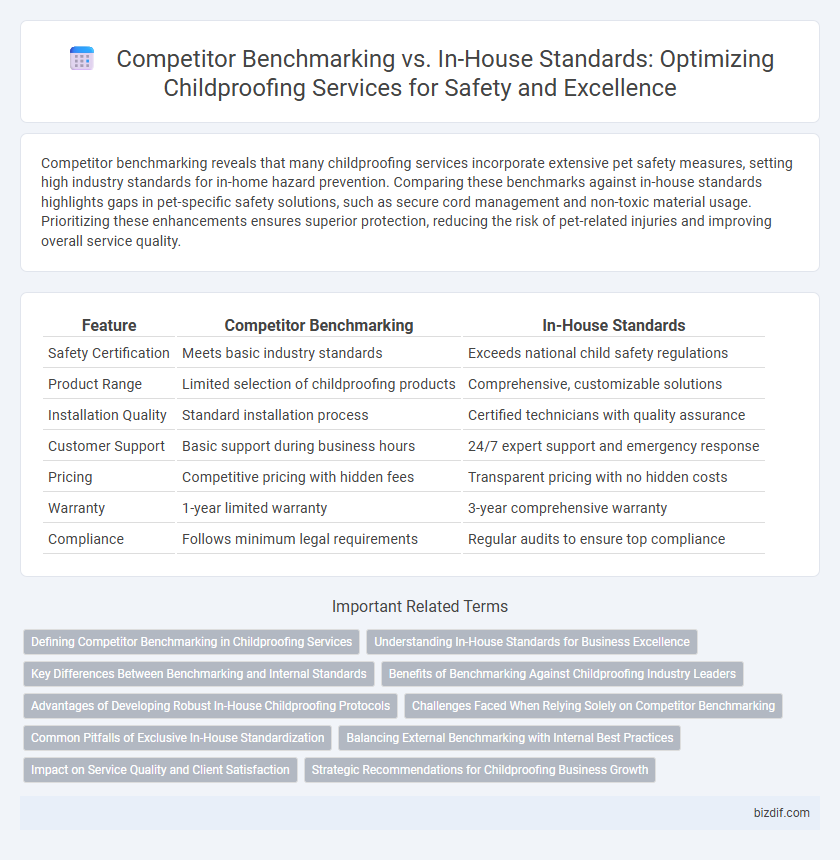Competitor benchmarking reveals that many childproofing services incorporate extensive pet safety measures, setting high industry standards for in-home hazard prevention. Comparing these benchmarks against in-house standards highlights gaps in pet-specific safety solutions, such as secure cord management and non-toxic material usage. Prioritizing these enhancements ensures superior protection, reducing the risk of pet-related injuries and improving overall service quality.
Table of Comparison
| Feature | Competitor Benchmarking | In-House Standards |
|---|---|---|
| Safety Certification | Meets basic industry standards | Exceeds national child safety regulations |
| Product Range | Limited selection of childproofing products | Comprehensive, customizable solutions |
| Installation Quality | Standard installation process | Certified technicians with quality assurance |
| Customer Support | Basic support during business hours | 24/7 expert support and emergency response |
| Pricing | Competitive pricing with hidden fees | Transparent pricing with no hidden costs |
| Warranty | 1-year limited warranty | 3-year comprehensive warranty |
| Compliance | Follows minimum legal requirements | Regular audits to ensure top compliance |
Defining Competitor Benchmarking in Childproofing Services
Competitor benchmarking in childproofing services involves analyzing and comparing the safety features, installation methods, and product quality offered by leading providers to identify industry best practices. This process helps establish measurable standards, such as the effectiveness of safety locks and corner protectors, ensuring services meet or exceed market expectations. By systematically evaluating competitor offerings, businesses can refine their childproofing solutions to achieve higher customer satisfaction and regulatory compliance.
Understanding In-House Standards for Business Excellence
In-house standards for childproofing services prioritize rigorous safety protocols, continuous staff training, and adherence to the latest regulatory guidelines to ensure optimal protection for children. Regular internal audits and quality control measures maintain consistency and uphold the company's commitment to excellence. Benchmarking competitors highlights areas for improvement and innovation, reinforcing a culture of continuous enhancement and client trust.
Key Differences Between Benchmarking and Internal Standards
Competitor benchmarking in childproofing services compares safety measures, product selection, and installation efficiency against leading industry players to identify market gaps and opportunities for improvement. In-house standards focus internally on consistent application, employee training, and adherence to company-specific safety protocols, prioritizing customization and operational control. The key difference lies in benchmarking driving innovation through external insights, while internal standards ensure quality through established, repeatable processes.
Benefits of Benchmarking Against Childproofing Industry Leaders
Benchmarking against childproofing industry leaders provides valuable insights into best practices, innovative safety solutions, and compliance standards, enabling companies to elevate their service quality and operational efficiency. This comparison highlights gaps in current offerings and identifies opportunities for adopting advanced childproofing technologies and materials, ensuring enhanced protection for children. Embracing industry benchmarks fosters continuous improvement, increased customer trust, and a competitive advantage in the child safety market.
Advantages of Developing Robust In-House Childproofing Protocols
Developing robust in-house childproofing protocols ensures tailored safety measures that align precisely with specific home environments, surpassing generic competitor benchmarks. This approach enhances compliance with up-to-date regulatory standards and fosters continuous improvement through direct feedback and hands-on experience. Investing in customized safety solutions reduces liability risks while building client trust through demonstrable expertise and accountability.
Challenges Faced When Relying Solely on Competitor Benchmarking
Relying solely on competitor benchmarking in childproofing services often results in overlooking unique safety needs specific to a home's layout and the child's behavior, leading to generic, less effective solutions. In-house standards, developed through direct experience and tailored assessments, provide more precise and adaptable safety measures that better mitigate risks. Competitor benchmarking can also stifle innovation by encouraging imitation rather than the development of customized, proactive childproofing strategies.
Common Pitfalls of Exclusive In-House Standardization
Relying solely on in-house standards for childproofing services often leads to outdated practices and missed innovations present in competitor offerings. Common pitfalls include limited risk assessment scope and neglecting diverse safety solutions, reducing overall effectiveness. Benchmarking against competitors ensures continuous improvement and alignment with industry best practices, enhancing child safety outcomes.
Balancing External Benchmarking with Internal Best Practices
Balancing external competitor benchmarking with in-house standards in childproofing services ensures continuous improvement while maintaining unique safety protocols tailored to specific client needs. Analyzing competitors' innovations and customer feedback can highlight industry trends and gaps, yet integrating these insights with internal best practices guarantees consistency and reliability in childproofing solutions. This strategic approach optimizes safety outcomes and sustains competitive advantage by combining proven internal expertise with relevant external benchmarks.
Impact on Service Quality and Client Satisfaction
Competitor benchmarking in childproofing services provides critical insights into industry standards, enabling the identification of gaps and areas for improvement in in-house protocols. By comparing service quality metrics such as response time, product safety compliance, and installer certification rates, companies can enhance client satisfaction through targeted upgrades. Maintaining rigorous in-house standards aligned with or exceeding competitor benchmarks directly influences positive customer feedback and repeat business.
Strategic Recommendations for Childproofing Business Growth
Conducting competitor benchmarking reveals key gaps in service offerings and pricing strategies compared to in-house standards, highlighting opportunities for differentiation. Integrating advanced safety technologies and tailored consultation packages can position the childproofing business as a market leader. Emphasizing customer-centric innovation and continuous team training will drive sustainable growth and higher client retention.
Competitor Benchmarking vs In-House Standards Infographic

 bizdif.com
bizdif.com